Part 2, "Connectors and other
intermittent problems" can be found here
Part 3, "Getting the Power" can be found here
Part 4, "MPU Board Troubleshooting" can be found here
Part 5, "Driver Board Troubleshooting" can be found here
Part 1 - Introduction to the Williams
Solid State Pinball Machine
1. Understanding the Williams Solid State Pinball Machine
Before attempting to troubleshoot an early Williams
Solid State Pinball machine, a good understanding of the major components and their corresponding functions is essential. The majority of
repairs can be accomplished by the average hobbyist as long as you know
what you're looking at. You can cause more damage to your machine by
idly poking a prodding around in a vain attempt to "repair"
without a good working knowledge of what everything does.
1.1 A Brief History and the Evolution of the Williams
Solid State Machines
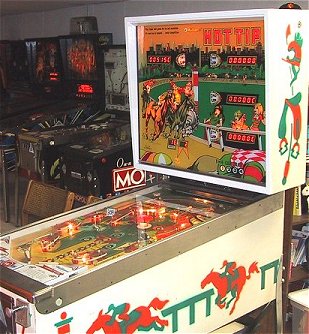 Williams introduced its first Solid State pinball
machine in late 1977. The machine was "Hot Tip" and was
also released in an electro-mechanical version. All Williams Solid
State games from Hot Tip in 1977 up to Laser Cue in 1984 shared the same basic
design architecture. In 1981 Williams made some major revisions to the MPU board
(System 7 board), but the overall architecture remained the same. In
1984 Williams introduced the System 9 board which combined a majority of
the functions onto a single board.
Williams introduced its first Solid State pinball
machine in late 1977. The machine was "Hot Tip" and was
also released in an electro-mechanical version. All Williams Solid
State games from Hot Tip in 1977 up to Laser Cue in 1984 shared the same basic
design architecture. In 1981 Williams made some major revisions to the MPU board
(System 7 board), but the overall architecture remained the same. In
1984 Williams introduced the System 9 board which combined a majority of
the functions onto a single board.
As you can tell by the preceding paragraph, early
Williams Solid State games are referred to by the revision number of the
CPU. Along with CPU revisions, other revisions were made along the
way to the sound boards, displays and display drivers and power
supplies. At times it can be daunting to know which board goes with
which system and what parts are interchangeable among systems.
The
following is a brief time-line in the evolution of the Williams Solid
State games:
- System 3 - Introduced in 1977 with "Hot Tip",
the System 3 board was Williams first production Solid State system.
Hot Tip and the second Solid State game, "Lucky Seven", did not have
electronic sound, but still relied on electro-mechanical chimes.
Electronic Sound was introduced in 1978 with "World Cup".
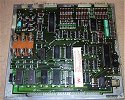
(System 3 MPU, click on photo for larger
image, picture will open in a new window)
System 3 games include Hot Tip (also released
in an electro-mechanical format), Lucky Seven
(also released in a two player electro-mechanical format), World Cup,
Contact and Disco Fever.
System 4 - The System 4 board was introduced in 1978
with "Phoenix" and
incorporated several minor enhancements to the clock and reset circuits. With Flash in
1979, Williams introduced the concept of "continuous" background
sound (and a corresponding new sound card).
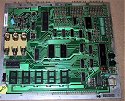 (System 4 MPU, click on photo for larger image)
(System 4 MPU, click on photo for larger image)
System 4 games include Phoenix, Pokerino,
Stellar Wars and Flash.
System 6 - The System 6 board was introduced in mid 1979
during the production run of "Flash". Quite a few major internal
enhancements were made on this board, including the addition of memory
protection and the use of the 6808 processor with its onboard
clock. It was the most widely produced
Williams MPU board every, with almost 100,000 units manufactured.
Williams introduced speech into the Pinball World in 1979 with "Gorgar"
and its seven word vocabulary.
 (click on photo for larger image)
(click on photo for larger image)
System 6 games include Flash (end of
production run), Tri-Zone, Time Warp, Gorgar, and Laserball.
System 6a - A minor revision was made in the System
6 board around the time of the release of Firepower. The data buffer
chips IC9 and IC10 were removed.
* The last two System 6 games, Algar and Alien Poker used 7 digit
displays.
Games shipped with System 6a boards include Firepower, Blackout,
Scorpion, Algar and Alien Poker.
System 7 - The System 7 board was introduced in late
1980 with "Black Knight". To the casual observer, a System 7 game
could be identified by its use of 7 digit displays. With the exception
of the sound board, all of the major components were revised from previous
games. Williams attempted to maintain "backwards"
compatibility with the System 7 board, however it required some soldering
(jumper changes) on the board or ROM revisions to allow it to work in
earlier games (you don't need to do that however, see my ROM page for
details on running System 7 boards in all System 3 to 6 games!). Later System 7 games switched from a 28 volt Flipper
coil to a 50 volt Flipper coil, adding an additional power supply and
transformer to the game.
 (click on photo for larger image)
(click on photo for larger image)
The major System 7 games were Black Knight,
Jungle Lord, Pharaoh, Solar Fire, Barracora, Firepower, Cosmic
Gunfight, Firepower II and Laser Cue.
Williams produced System 7 games in very limited quantities, few of
which still exist today. Varkon (90), Thunderball (10), Defender
(350), Time Fantasy (600), Warlock (400), Joust (400).
I'm not sure whether it was the recession or the video game
revolution, but Williams produced less than 3,000 pinball games in
1982 and 1983 combined after having produced over 75,000! pinball
games in 1981 and 1982.
System 9 - The System 9 board was introduced in 1984
with "Space Shuttle" and marked the first major architecture change for
Williams since its introduction of solid state games. The concept of using separate MPU, Driver and Sound boards
was replaced with a single board. Externally, a casual player
wouldn't notice any difference between a System 7 and System 9 game as
they both used 7 digit numeric displays.
System 11 - The System 11 board was introduced in
1985
with High Speed. It was also a "combined" board with CPU,
driver and sound all located on the same board. System 11 games used
both alpha-numeric and numeric displays. Later System 11 games used
only alpha-numeric displays. The System 11 board went through 4
revisions and the boards were given "dash" suffixes, i.e.,
System 11a, System 11b.
WPC - The WPC System, "Williams Pinball
Controller", was introduced in 1991 with Funhouse These games
featured Dot Matrix Displays (DMDs) (although Funhouse still utilized
alpha-numeric displays). An interesting note is that
Williams switched back to separate MPU and Driver boards with the WPC
System.
WPC95 - Williams caught Microsoft's naming bug in 1995
with the release of the WPC95 system.
Pinball 2000 - Continuing with the Microsoft naming
convention, Williams introduced Pinball 2000 in 1999 with "Revenge
from Mars". A hybrid video-pinball system that introduced a
3-dimensional "virtual" playfield, only 2 Pinball 2000 titles
were produced before Williams pulled out of pinball manufacturing in
October of 1999.
1.2 So what works with what? Here is a brief rule of
thumb for part compatibility between Williams Solid State games:
- System 3 through 6 games share the most compatibility.
They all use the same driver board, displays and display
driver. The MPU boards are backwards compatible, in that you can use
a System 6 board from a Time Warp in a Hot Tip.
- Early power supplies also contained a 300 volt feed for
the display driver that was later dropped. You can use the power
supplies interchangeably between system 3 and 6 games. System 7
power supplies were redesigned with the GI circuit being added back in.
You can use a System 7 power supply in a System 4-6 game. There will
be three connectors that are not used and you will need to add a fuse to
F4 for System 6 games.
- Transformers on earlier games also used slightly
different plug arrangements. System 3 games routed the GI power
through the power supply board while later games had direct connections to
the fuse block for the GI circuit. If you are swapping transformers,
make sure you have the GI power routed properly. System 7 game
transformers are also compatible with earlier games. Because they
were mounted in the cabinet, they will have a connector on the +28 and +18
volt secondary outputs. This just needs to be cut off to use the
transformer in a System 3-6 game.
- Williams used three different sound boards in these
systems, and they are specific to certain games. World Cup through
Pokerino share the same card, then Flash through Scorpion, and finally
Gorgar through Alien Poker.
- System 7 games use a slightly modified Driver
board. 8 resistors in the switch matrix were replaced with jumpers.
A common misconception is that driver boards are backwards compatible
between System 7 and System 3-6 games. NOT TRUE! Using a
jumpered System 7 driver board in a System 6 game may result in random
switch closures during game play. Using a System 3-6 game in a
System 7 game will result in switch closures being missed. USE THE
RIGHT DRIVER BOARD FOR YOUR GAME!
- System 7 MPU boards can be used in System 4 to 6
games. System 3 games (games using the White Flipper ROMs) can be
run on System 7 boards, however you will need to accept the
"factory" settings since most System 7 boards lack the DIP switches
required to program the options. There are two ways to run the
software on a System 7 board. The first requires a series of jumper
changes (soldering required), the second is to used a "doubled
up" Flipper ROM and the existing game ROM. This method requires
no jumper changes. You can get
the new Flipper ROMs here.
Early System 7 boards did have dip switches and LEDs (see below) and
the ability to accept adjustment programming via the dip switches.
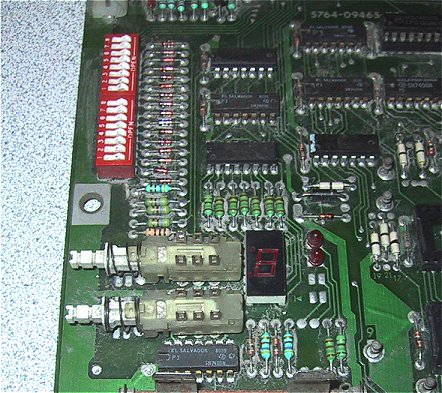
- System 9 games share the same power supplies (main and
flipper) and displays with System 7 games. Although
the display driver board is the same design electronically, Williams
switched from edge connectors to plug connectors on some System 9 display
driver boards. The speech boards may also look the same, but System
9 speech boards are designed to use 2732 EPROMs, while System 6 and 7
speech boards use 2532 EPROMs, so the two are not compatible without a
jumper change.
- No System 11 or later parts, other than 7 digit numeric
displays, are plug compatible with earlier games. However, I have been told
that a System 11 board can be used in a System 9 game! System 11
power supplies can be used in older games if a modification is made to the
GI circuit.
1.3 Williams System 3 through 7 Design Architecture
All Williams System 3 through 6 games share the same
design architecture. For the most part, System 7 games do also,
albeit with some modifications that will be discussed later.
Williams, like the other major pinball manufacturer's of
the time, used what is sometimes called a "split board" design,
in that the MPU and driver functions are separated onto two different
boards. This was done to facilitate the field repair of the
machines. The tech would only need to swap out the failing board with a
replacement and take it back to the shop for repair. The prevailing
thought at the time these boards were designed is that the driver boards
were much more likely to fail than the MPU boards. If the boards had
been designed as a single unit, then a tech would need to carry ROM chips
for each machine on the operator's route and swap them out when replacing
the board. However if the driver board were separate from the MPU
board, then no ROM swap would be necessary for the majority of repairs.
This philosophy actually held true, as driver boards
have proven much more likely to fail then the MPU. What Williams and
the other manufacturers didn't bargain for however was the failure of the
connectors between the driver and MPU boards. Gottlieb had the worse
problem due to its use of personal computer style "edge"
connectors that relied on the thin coating of copper on the board for the
interconnection. Williams boards are far from exempt however due to
the decision to extend the CPUs address and data lines across the
interconnection. This requires the pins to provide high speed data
transfer, where as dirt and loose connectors can bring the game to a halt.
All games share the same five major components, the MPU
(or CPU) board, the Driver board, the power supply, the display driver and
the displays. All games after Lucky Seven also had a sound board,
and later System 6 games and early System 7uch as Gorgar, Blackout, Firepower
and Black Knight had
speech boards.
For reasons unknown, all System 3 and most System 4 games had their
sound boards located in the cabinet, while later System 4 games and System 6
and 7 games had their sound
boards located in the back box.
Inside of a typical Williams System 6 back box:
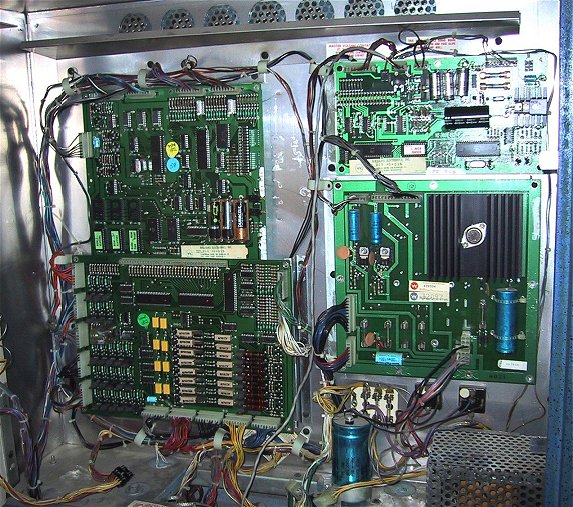
MPU Board
Williams calls its CPU boards, "MPU" boards
(just to be different I guess!). The MPU board contains the
microprocessor, diagnostic and display logic. Williams games were
designed around the Motorola 6800 series of chips. Also contained on
the MPU board are the game's ROM (Read-Only Memory) chips that contain the
game specific program. The diagnostics on a Williams MPU board
consists of two LEDs. A common mis-conception is that Williams
boards do a "self-test" like the boards from other
manufacturers. In reality, a self-test only occurs when you press
the test button.
Driver Board
The Driver board in early Williams Solid State games is
actually an extension of the MPU board. The Driver board controls
the solenoids and lamps and reads the switches. The 6808 microprocessor
used in these games communicates to the "outside" world (the
game in this case) through the use of what are known as "PIA"
chips. PIA stands for "Peripheral Interface
Adapter". These chips have the designation 6821, however early
driver boards may have used 6820 chips (which can be replaced with 6821
chips) In a personal computer, examples of peripherals are the
keyboard, disk drive and modem. In a pinball game, peripherals are
the displays, switches and solenoids. The switch "reading"
mechanism in a pinball game is identical to that of the keyboard reading mechanism
in a personal computer. A PIA chip has an "address" just
like a memory or ROM chip does and is accessed by the microprocessor in
the same fashion. The game's program "reads" the PIA to
see what switches are down and it "writes" to the PIA to fire a
solenoid or change the score.
Games through System 6 games used four PIA chips.
One on the MPU board to control the displays and three on the Driver
board. One controls the Solenoids, one controls the lamps and one
reads the switches. Because the PIA chips are seen as memory
locations by the microprocessor, any failure of a PIA chip will most
likely cause the game to "lock-up" because the game's program
cannot read or write to these memory locations. This is also why a
MPU board will not "boot" without the driver board
installed. There are special diagnostic chips available that will
allow you to test the MPU board with the driver board detached.
System 7 games have an additional PIA on the MPU board
that is used to drive the Sound Board. This leaves more driver board
solenoid connections available for playfield coils.
The PIA chips are easily identifiable, as they are the
large 40 pin chips on the board. Don't worry if your chips don't say
6821 on them. Williams bought these chips in large quantities which
were manufactured specially for them and they have a proprietary
designation on them.
The electrical current used in a pinball game would fry
a 6821 in a nano-second! To prevent this a series of IC (integrated
circuit) chips and transistors are used in between the PIAs and the rest
of the game. The ICs also provide other controls which will be
discussed later.
Power Supply
I think the power supply is one of the most
misunderstood
parts of the game. There are actually multiple independent power
circuits in the game. People will replace parts of one circuit
thinking they are fixing another.
All games through System 7 have the following power
circuits:
+5volt regulated DC "logic" power
+12 volt unregulated DC
+100 and -100 volt DC display power
+28 volt solenoid and flipper power
+15 volt lamp power
6 volt AC GI (General Illumination) lamp supply
The two bridge rectifiers bolted to the backbox are for
Solenoid and Lamp power and have nothing to do with the logic (CPU)
power. Same goes for the large capacitor mounted in the back box,
its used for the lamp power supply only.
Another often confused area is the value of the +12 volt
unregulated power circuit. Since it is not regulated, it will vary
depending on the line voltage. It can range anywhere from 10 to 14
volts, and this is normal. This voltage is monitored by the MPU
board to determine when you've turned off the power so it can shut down
things like the displays so they're not damaged during power down.
People will attempt to "repair" their power supplies because
they're not getting 12 volts, only 11 volts.
Later System 7 games used 50 volt flipper coils and had
an additional "flipper" power supply board (and an additional transformer
in the cabinet).
Sound Board
The first two Williams Solid State games, Hot Tip and
Lucky Seven, continued to use "chimes" like the
electro-mechanical games. Hot Tip also had a "dummy" score
reel in the cabinet that would be incremented to make the familiar scoring
sound. World Cup was the first Williams game to
use electronic sound. Sound boards are actually self-contained
computers, complete with their own power supply, microprocessor and PIA.
The game "sees" the sound board as a set of solenoids, using the
same controls on the driver board to trigger different sounds as it would
to fire a solenoid.
Games from World Cup to Pokerino used a sound board that
would generate a sound when an activity occurred (scoring, etc.).
However when the ball wasn't hitting anything, no sound was being
produced. Starting with Flash, a revised sound board was used that
would generate "constant" or "continuous" background sounds. These usually
varied in pitch as scoring increased, giving the player an adrenaline
boost when things really got going.
Gorgar introduced speech to the pinball world. A
redesigned sound board featured a connector for an add-on speech
module. Speech was featured on Gorgar, Firepower, Blackout,
Alien Poker, Black Knight, Jungle Lord and Pharaoh. The recession of
the early 80s that almost drove Williams out of business caused major cost
cutting moves in pinball production, and speech was eliminated from all
System 7 games after Pharaoh. The sound board in these later games
is missing the connector that was used to connect the ribbon cable from
the speech board to the sound board, showing how far they went in reducing
production costs.
Displays
Williams used a standard 6 digit gas filled display in
all its games through Algar. These are still widely available today. Most
displays today have a "nipple" where they were sealed.
These will work fine as a replacement, and most display boards already
have a hole drilled in them. The last two System 6 games (Algar and
Alien Poker) use 7 digit displays and all System 7 games used a 7 digit display.
Display Driver
The display driver is mounted just behind the backglass
on the front of the display panel. The display driver also contains
the credit/match display. The job of the display driver is to take
the binary score data coming from the MPU board and translate into the
signals understood by the displays.
There were two versions of the display driver
manufactured, and both are compatible in all games. One uses
"discreet" components (meaning a large number of individual
transistors) and the other uses integrated circuits. The reason for
this is that the UDN6184 "segment driver" chip that Williams
used became very short in supply. Williams designed an alternate
board that replaced the functionality of the UDN6184 with individual
transistors. The UDN6184 chip continues to be in short supply today,
and averages between $15 and $20 a piece.
Display board from a System 6 game showing the 4 score
displays and the combination display driver/credit match display unit:
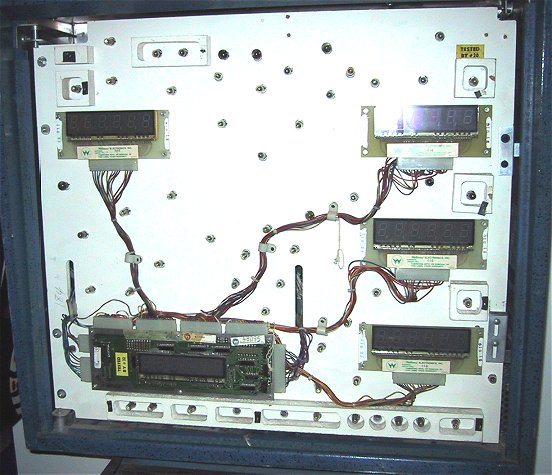
Go to Section 2,
"Connectors and other Intermittent Problems"

 Williams introduced its first Solid State pinball
machine in late 1977. The machine was "Hot Tip" and was
also released in an electro-mechanical version. All Williams Solid
State games from Hot Tip in 1977 up to Laser Cue in 1984 shared the same basic
design architecture. In 1981 Williams made some major revisions to the MPU board
(System 7 board), but the overall architecture remained the same. In
1984 Williams introduced the System 9 board which combined a majority of
the functions onto a single board.
Williams introduced its first Solid State pinball
machine in late 1977. The machine was "Hot Tip" and was
also released in an electro-mechanical version. All Williams Solid
State games from Hot Tip in 1977 up to Laser Cue in 1984 shared the same basic
design architecture. In 1981 Williams made some major revisions to the MPU board
(System 7 board), but the overall architecture remained the same. In
1984 Williams introduced the System 9 board which combined a majority of
the functions onto a single board.





